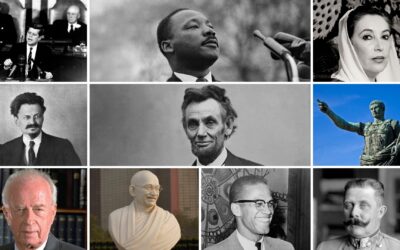Economic Systems and the Cold War: The Ballet of Capitalism and Communism
In the heart of the bustling metropolis of New York City, there’s a large bronze statue of a charging bull, symbolizing the aggressive financial optimism and prosperity of the capitalist world. Thousands of miles away, in the vast expanse of Moscow, stand remnants of statues showcasing workers and farmers, epitomizing the collective spirit of the communist era. These emblematic representations offer a fascinating glimpse into the two dominant economic ideologies that played a central role in the Cold War narrative: Capitalism and Communism.
The Theoretical Backbone: Capitalism vs. Communism
At its core, Capitalism, with its roots in the West, especially the US, champions the idea of private ownership and the free market. In a capitalist system, decisions regarding production, investment, and distribution are driven by individuals or corporations in the marketplace, and prices for goods and services are determined by competition and consumer demand.
On the other hand, Communism, which found its most notable advocate in the form of the Soviet Union, argues for communal ownership of the means of production. Here, the state typically makes decisions regarding what, how, and for whom to produce, aiming to ensure that wealth and power are evenly distributed among its citizens, eliminating class distinctions.
A Tale of Two Economies: US vs. USSR
Through the lens of time, the economic trajectories of the US and USSR serve as intriguing study contrasts.
The post-World War II era saw the US, untouched by the devastations of war on its mainland, blossom into an economic powerhouse. The American Dream, with its ethos of individual aspiration and potential for upward mobility, took root. Corporations expanded, industries boomed, and the consumer-driven economy thrived. Suburbs grew, cars became a household staple, and a burgeoning middle class, fueled by capitalist gains, became the backbone of the American society.
The Soviet economy, on its part, had a different tale to tell. After facing significant devastations during the World War II, the USSR undertook massive state-driven industrialization and collectivization drives. The state controlled major sectors, setting production targets, and prices, aiming for rapid economic growth. And for a while, it worked. The USSR saw significant advancements in sectors like space technology and defense. However, the lack of consumer choice, the inefficiencies of a centrally planned economy, and the suppression of individual entrepreneurial spirit became its Achilles’ heel.
The Global Dance: Influences and Echoes
The Cold War wasn’t just a tussle of military might; it was a showcase of economic prowess. Nations across the world, emerging from the shackles of colonialism and looking to chart their economic futures, were often torn between these two models.
Many African and Asian countries, not wanting to be ensnared in this bipolar world order, adopted mixed economies, taking elements from both systems. Yet, the global financial institutions, like the World Bank and International Monetary Fund, championed more capitalist, market-driven reforms, often tying their loans and aids to these conditions.
The Marshall Plan, an American initiative, infused war-torn Europe with funds but also subtly ensured the spread and dominance of capitalist ideals in the region. The USSR countered with the Molotov Plan and later Comecon, helping to rebuild Eastern Europe but binding them to the communist economic model.
The Cracks Emerge: The Soviet Decline
The 1980s was a turning point. The inefficiencies of the Soviet economic model started becoming more evident. Central planning, while effective in the initial stages of development, proved stifling for innovation and consumer choice in the long run. The technological and consumer-driven advancements in the West, particularly the US, contrasted sharply with the stagnation in the Soviet realm.
Mikhail Gorbachev’s introduction of “glasnost” (openness) and “perestroika” (restructuring) were last-ditch attempts to infuse life into the ailing Soviet economy. These reforms aimed to incorporate elements of the free market while retaining communist ethos. However, these measures, while revolutionary, came too little too late. The USSR’s centralized economic structure, combined with political pressures and the race to keep up with the US’s defense and technological innovations, led to its eventual disintegration.
Epilogue: Lessons from a Bygone Era
Today, as we stand in a world dominated by market-driven economies, it’s essential to reflect on the lessons the Cold War era offers. It’s a testament to the fact that while economic ideologies can guide nations, rigidity can be their downfall. The ability to adapt, reform, and evolve is the cornerstone of not just economic, but holistic, national progress.
Both Capitalism and Communism, as ideologies, have their merits and flaws. The Cold War era showcases the consequences of their extremities, urging present and future generations to adopt a more balanced, inclusive, and sustainable economic vision.
Keywords:
- Metropolis: A very large and important city.
- Emblematic: Serving as a symbol of a particular quality or concept.
- Communal ownership: A system in which property, especially in production means, is owned collectively by a community or society.
- Trajectories: The path followed by a moving object, figuratively used here to indicate the path or course of the US and USSR economies.
- Burgeoning: Begin to grow or increase rapidly.
- Achilles’ heel: A weakness or vulnerable point.
- Bipolar: Having two extremes or poles, here referring to the dominant power structures of the US and USSR.
- Ensnared: Catch in or as in a trap.
- Glasnost: A policy of increased openness, transparency, and freedom of speech introduced in the Soviet Union in the late 1980s.
- Perestroika: A political movement within the Communist Party of the Soviet Union during the 1980s, widely associated with the Soviet leader Mikhail Gorbachev. It’s often argued to be the cause of the dissolution of the Soviet Union.
Key Takeaways:
- The Cold War was as much an economic battle as it was political, with Capitalism and Communism being the central ideologies.
- The US and USSR adopted contrasting economic models, with the US emphasizing individual enterprise and the USSR focusing on state control.
- While both economies had periods of growth, by the 1980s, the cracks in the Soviet system started to show, leading to attempts at reform.
- The Cold War influenced global economic policies, with newly independent nations often finding themselves having to choose or balance between these two models.
- The inability of the Soviet Union to adapt and evolve its economic model played a significant role in its eventual decline.
Check out the Story of the Cold War Article Series
Cold War Chronicles: From Superpower Showdowns to Silent Echoes (Featured Article)
The Nuclear Arms Race: An Era of Fear and Hope
CIA vs. KGB: The Hidden Wars of the Cold War Era
The Cold War’s Echo in Africa: Decolonization and Proxy Battles
The Non-Aligned Movement: Navigating the Cold War’s Tumultuous Seas
Echoes of the Cold War: Its Indelible Mark on Popular Culture & Media
Capitalism vs. Communism: The Economic Tug of War during the Cold War










0 Comments